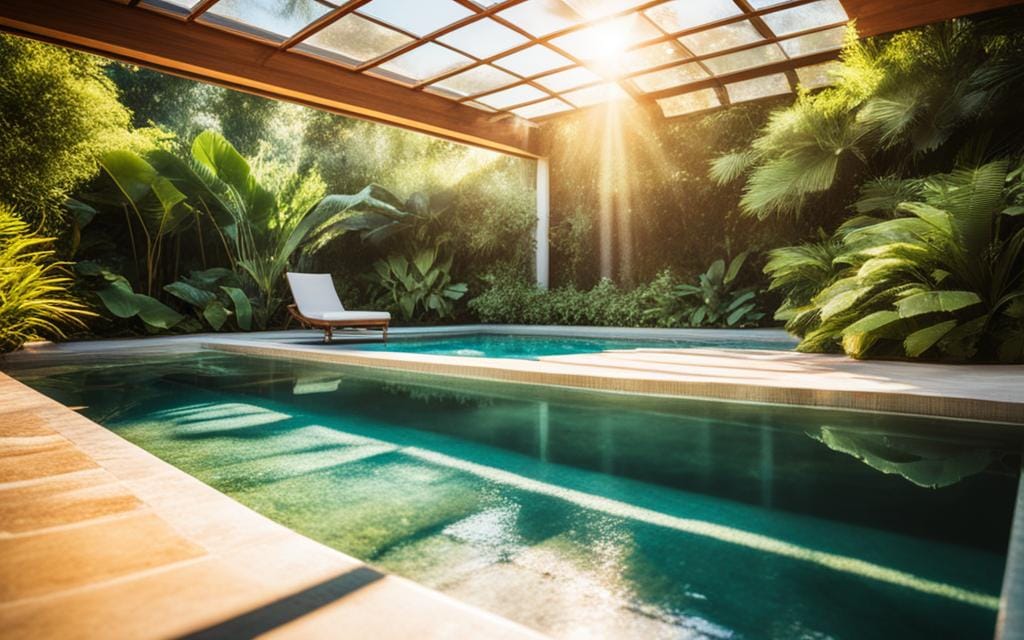Pool owners always look for ways to keep their saltwater pools perfect. A common question is if sunlight can lower the salt in the water. We’ll look into the science behind this and see what affects salt levels in your pool.
Sunlight is key to your pool’s water chemistry. Knowing how it changes salt levels helps us make smart choices. This keeps the water comfortable and efficient for swimming.
Let’s dive into how sunlight and salt levels are connected. We’ll give you tips to keep your saltwater pool great, even with different weather.
Table of Contents
ToggleUnderstanding the Role of Salt in Pool Water
Adding salt to pools is common, especially in saltwater systems. But what is salt and why do we add it to pools? Let’s look at how salt helps pool water and the benefits of saltwater pools.
What is Salt and Why is it Added to Pools?
Salt, or sodium chloride (NaCl), is a mineral we use in pool water. It turns into chlorine through electrolysis, keeping the water clean and safe.
In saltwater pools, the salt level is lower than in the ocean. It ranges from 2,500 to 5,000 parts per million (ppm). This amount keeps the water clean and feels natural for swimmers.
Benefits of Salt Water Pools
- Reduced chemical usage: Saltwater pools use less harsh chemicals, making the water kinder to skin and eyes.
- Improved water quality: The chlorine made from salt keeps the water clean and balanced, cutting down on manual chlorine additions.
- Cost-effective: Saltwater pools can be cheaper to maintain over time, needing fewer chemical changes.
- Gentle on the skin: The salt in the water makes swimming more comfortable, especially for those with sensitive skin or eyes.
Salt is key to keeping saltwater pools running well. It offers many benefits that make swimming more enjoyable and cost-effective.
The Effects of Sunlight on Pool Water Chemistry
As pool owners, we know keeping the right balance of chemicals is key. But, we might not realize how sunlight affects our pool water’s chemistry.
Sunlight’s UV rays change the chemicals we use to keep pools clean. They break down chlorine and other sanitizers. Also, the sun makes water evaporate faster, changing chemical levels.
When water evaporates, it leaves behind more salt and other solids. This makes the pool water too salty. We need to adjust the balance to keep it right.
| Effect | Impact |
|---|---|
| UV Radiation | Breaks down chlorine and other chemicals |
| Evaporation | Increases concentration of dissolved solids, including salt |
Knowing how sunlight affects pool water is key to keeping our pools healthy. By understanding this, we can keep our pools safe and fun for everyone.
Will Sunlight Reduce the Amount of Salt in a Pool?
Examining the Scientific Evidence
Many studies have looked into how sunlight affects salt levels in pool water. They’ve found some interesting things. These studies help us understand what makes salt levels change in pools.
Sunlight can make pool water evaporate, leaving more salt behind. This means salt levels might go up as the water level drops. But, how fast this happens depends on things like the temperature, humidity, and wind.
| Factor | Effect on Salt Loss |
|---|---|
| Sunlight exposure | Increases evaporation, leading to higher salt concentration |
| Temperature | Higher temperatures accelerate evaporation, contributing to salt loss |
| Humidity | Lower humidity levels enhance evaporation and salt loss |
| Wind | Increased wind speed can increase evaporation and salt loss |
Sunlight can make salt levels go up by making water evaporate. But, studies don’t show that sunlight directly lowers salt levels in pool water. Things like water volume, temperature, and the environment play a bigger role.
To sum up, sunlight can make salt levels go up by speeding up evaporation. But it doesn’t directly lower the total salt in the pool. Keeping salt levels right in a pool needs a careful look at many factors and good management.
Factors Influencing Salt Loss in Pools
Sunlight can lower salt levels in pools, but it’s not the only thing that does. Many other things can make your pool lose salt. Let’s look at the main things that affect salt loss, like temperature, evaporation, pool covers, and shade.
Temperature and Evaporation
The temperature of your pool water greatly affects salt loss. When the water gets hotter, more water evaporates. This means the salt stays behind, making the salt level go up. But when the water cools down, less water evaporates, so there’s less salt loss.
Pool Covers and Shade
Using a pool cover or putting shade near your pool can help keep the salt in. Pool covers stop more water from evaporating. Shade, from trees or a special structure, makes the water cooler and slows down evaporation. This keeps the salt levels steady.

Knowing about these factors and how to manage them helps keep your pool’s salt level right. This makes swimming more enjoyable and balanced.
Maintaining Proper Salt Levels in Your Pool
Keeping your pool’s salt levels right is key to good pool care. The right salt level helps keep your water chemistry balanced. It also makes the most of your saltwater pool’s benefits.
Testing and adjusting salt levels often is crucial. Here’s a simple guide to help you manage your pool’s salt levels:
- Check the salt levels weekly with a reliable test kit. This lets you see if levels are changing.
- Add salt if levels are low, following the maker’s guide. The amount depends on your pool’s size and current salt level.
- To lower high salt levels, drain and refill the pool with fresh water. Always check the levels after adjusting.
- Watch the salt levels closely during busy times or after rain. These can change the concentration.
Regular testing and adjustments keep your pool’s salt levels in check. This keeps your water chemistry balanced and your saltwater system working well. It also helps keep your pool healthy and your equipment lasting longer.
Alternative Methods for Reducing Salt Levels
If sunlight alone doesn’t cut it for lowering your pool’s salt, there are other ways to help. Let’s look at two good options: partial water changes and salt removal systems.
Partial Water Changes
Regular partial water changes can effectively lower salt levels in your pool. By draining and refilling with fresh, low-salt water, you dilute the salt. This keeps your pool water balanced.
Start by draining and replacing 10-20% of the pool’s water every few weeks. This slow method lets you check the results and adjust as needed. It keeps your pool’s salt levels just right.
Salt Removal Systems
For a focused way to lower salt, think about a salt removal system. These systems use advanced tech to remove extra salt while keeping minerals balanced.
They’re a smart choice for pools with high salt levels. They automate the process, saving you time on pool chemistry.
Using partial water changes and a salt removal system together works great. It keeps your pool safe and fun for everyone.
Pros and Cons of Saltwater Pools
Choosing between a traditional chlorine pool and a saltwater pool is a big decision for homeowners. Each type has its own benefits and drawbacks. It’s key to look at both sides before deciding. Let’s explore the good and bad of having a saltwater pool.
Advantages of Saltwater Pools
- Gentler on skin and eyes: Saltwater pools use a lower concentration of chlorine. This makes them less irritating to the skin and eyes than traditional pools.
- Reduced maintenance: These pools need less frequent chlorine addition. The salt turns into chlorine automatically, cutting down on upkeep.
- Cost-effective in the long run: Although they cost more to set up, saltwater pools save money on maintenance and chemicals over time.
- Environmentally friendly: They use fewer harsh chemicals, making them a greener choice for pool owners.
Disadvantages of Saltwater Pools
- Higher initial cost: Setting up a saltwater pool costs more than a traditional one upfront.
- Potential for corrosion: Salt can harm some pool equipment and materials, so you need stronger parts.
- Increased energy consumption: The system to make chlorine from salt uses more electricity, raising your bills.
- Maintenance requirements: While they don’t need as much chlorine, they still need regular checks on the salt cell and other parts.
Think carefully about the pros and cons of saltwater pools to see if they fit your home and lifestyle. Talking to a professional pool expert can also give you useful advice to help you decide.
Tips for Optimizing Your Saltwater Pool Experience
Keeping a saltwater pool in top shape takes some effort, but it’s worth it. Here are some tips to help you care for your saltwater pool. These tips will make sure you enjoy your pool for a long time.
Maintain Proper Water Balance
It’s important to check and adjust your pool’s water chemistry often. Keep an eye on the pH, alkalinity, and chlorine levels. If these levels get out of balance, it can damage your pool equipment and make the water unpleasant.
Optimize Your Saltwater Chlorine Generator
Make sure your saltwater chlorine generator is working right. Clean the cell often and watch its chlorine output. Replace the cell when it’s needed to keep your pool clean.
Perform Routine Maintenance
- Brush the pool walls and floor often to stop algae from growing.
- Clean the pool filter as needed to keep the water moving well.
- Check and replace any broken or old pool equipment, like pumps or valves.
Protect Your Investment
Getting a good pool cover can cut down on water loss and keep the water level steady. This means you won’t have to refill your pool as much. Also, using shade or a cover can protect your pool from the sun. This helps keep the saltwater chemistry right.
| Saltwater Pool Care Tip | Description |
|---|---|
| Maintain Proper Water Balance | Regularly test and adjust pH, alkalinity, and chlorine levels to keep your pool’s water chemistry in optimal condition. |
| Optimize Saltwater Chlorine Generator | Clean the cell regularly and monitor its output to ensure your pool is properly sanitized. |
| Perform Routine Maintenance | Brush the pool, clean the filter, and replace worn or damaged equipment to maintain your pool’s performance. |
| Protect Your Investment | Use a pool cover and shade to minimize water evaporation and protect the saltwater chemistry from direct sunlight. |
Follow these tips for saltwater pool care and maintenance for a worry-free pool experience. Regular care means your pool will last longer and be ready for fun every time you want to swim.
Conclusion
We’ve looked into how sunlight affects salt levels in pools. We found that sunlight can slowly lower salt levels. But, it’s not the only thing that matters for keeping salt levels right in your pool.
Understanding the science behind saltwater pools helps us manage them better. We learned how temperature, evaporation, and pool covers play a part. With the right care, we can keep our saltwater pools perfect. This means enjoying water that feels soft and using fewer chemicals.
Managing salt levels in a pool means knowing how the pool works and keeping up with maintenance. By watching the levels and using smart ways to manage the pool, we can keep our saltwater pools great. This way, we can enjoy a refreshing and relaxing pool for many years.
FAQ
What is salt and why is it added to pools?
Salt is often used in pools, especially in saltwater systems. It helps make pools with saltwater. This type of pool has better water quality and uses less chemicals.
What are the benefits of saltwater pools?
Saltwater pools have many advantages. They have softer water, which is gentler on skin and eyes. They also need less maintenance than traditional chlorine pools.
How does sunlight affect the chemistry of pool water?
Sunlight changes the chemistry of pool water. The sun’s UV rays and evaporation affect the water’s chemical makeup, including salt levels.
Can sunlight reduce the amount of salt in a pool?
Sunlight and salt levels in pools are linked in a complex way. While sunlight can cause salt to evaporate, how much it affects salt levels varies by other factors.
What other factors influence salt loss in pools?
Many things affect salt loss in pools, not just sunlight. Temperature, evaporation, pool covers, and shade also play a part. Knowing these can help keep salt levels right.
How can I maintain proper salt levels in my pool?
It’s important to keep salt levels in your pool right for good water chemistry. You can do this by testing the water often, adjusting salt as needed, and using methods like partial water changes or salt removal systems.
What are the pros and cons of saltwater pools?
Saltwater pools have many benefits but also some downsides. They require an initial investment, can corrode equipment, and need special care.
What tips can you provide for optimizing my saltwater pool experience?
For a great saltwater pool, keep the water balanced and your equipment working well. Follow the best care and maintenance practices for saltwater pools.









